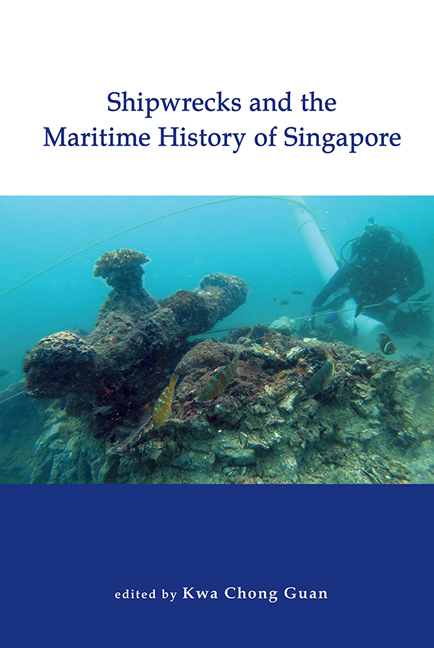Book contents
- Frontmatter
- Contents
- Foreword
- Acknowledgements
- Contributors
- 1 Introduction: Two Historical Shipwrecks and Their Implications for Singapore History
- 2 The Temasek Wreck
- 3 The International History of Temasek: Possibilities for Research Emerging from the Discovery of the Temasek Wreck
- 4 Singapore’s Waterways before the Modern Era
- 5 A Seventeenth-Century Port Settlement in the Kallang Estuary
- 6 The Shah Muncher
- 7 Singapore and the Country Trade in the Late Eighteenth and Early Nineteenth Centuries
- Index
4 - Singapore’s Waterways before the Modern Era
Published online by Cambridge University Press: 01 March 2024
- Frontmatter
- Contents
- Foreword
- Acknowledgements
- Contributors
- 1 Introduction: Two Historical Shipwrecks and Their Implications for Singapore History
- 2 The Temasek Wreck
- 3 The International History of Temasek: Possibilities for Research Emerging from the Discovery of the Temasek Wreck
- 4 Singapore’s Waterways before the Modern Era
- 5 A Seventeenth-Century Port Settlement in the Kallang Estuary
- 6 The Shah Muncher
- 7 Singapore and the Country Trade in the Late Eighteenth and Early Nineteenth Centuries
- Index
Summary
Standing at the beach in East Coast Park, the eye is struck immediately by the huge ocean liners and cargo ships anchored out at sea as far as the horizon. On an exceptionally clear day it is possible to see as far as Batam, just across the Singapore Strait. At night, the lights from the ships come on, like shimmering little bonfires dotting the line of water. From land, this is an image of idyllic calm and irrepressible peace, with the sound of the waves taking one far from the chaos and bustle of the city. Yet this image is deceptive. Unless one has spent time at sea, it would not be immediately apparent that the reality is far less irenic and immutable. Indeed, for much of Singapore's history, the waters in and around the island had an unsavoury reputation as a place of danger and death. Traversing the Singapore Straits in the past often tested the mettle of a captain, and recounting this experience of the voyage formed a favourite subject in tales and lore, many of which have been forgotten today. The aim of this essay therefore is to provide a short history of sailing past Singapore, to familiarize those on terra firma with the four different waterways that sailors used and the incipient dangers they faced when navigating past the island before the modern era. This brief overview will equip the reader with a more seaward perspective and help to locate Singapore's arteries within a larger maritime framework.
Defining the Singapore Straits
The Singapore Strait (singular) is a body of water situated south of the Island of Singapore, separating the tip of the Malay Peninsula from the islands of Riau. Running approximately 113 kilometres in length, it includes small islands and reefs and merges, from west to east, the Melaka Strait and the Karimata Strait with the South China Sea. Today, the narrowest navigable part of the strait is between Singapore's southernmost island, Pulau Satumu, and Indonesia's Pulau Takong Besar, which is a distance of a mere 5.2 kilometres. Its widest point, by contrast, measures some 20 kilometres, between Malaysia's Tanjong Rumania and Bintan, of Indonesia's Riau Islands archipelago.
- Type
- Chapter
- Information
- Shipwrecks and the Maritime History of Singapore , pp. 51 - 69Publisher: ISEAS–Yusof Ishak InstitutePrint publication year: 2023



